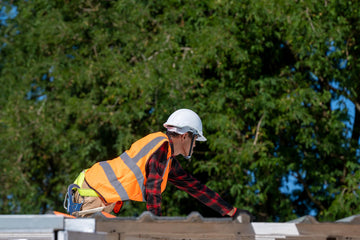Three steps to a safe and sustainable construction site
A big thank you to Green&Blue for asking Tradesman Saver to guest write this blog. We’re impressed with the amazing work the team has been doing to reconnect us with nature.
What follows are three steps tradespeople can take to improve sustainability and safety on site.
1. Construction and Biodiversity
In 2020, Brighton and Hove became the first council to make Bee Bricks compulsory in new builds and extensions. Since the changes, over 100 councillors across the UK have expressed interest in making Bee Bricks part of their building policy.
Construction has a huge impact on the natural world, and every effort should be made to reduce disruption. Start by reviewing access to the site. This is less of an issue for larger towns and cities, but villages often have narrow roads. If you need to get materials to your client, make sure trucks and vans avoid damaging trees, bushes, and walls.
On larger builds, the earlier you plan the better. Hiring an expert ecologist to survey the area before ground is broken is a crucial starting point and will help avoid delays during the project.
The ecologist will identify species that could be negatively effected by construction, as well as any legally protected species, in the area. They will also suggest the best time of year to begin work. Some species, such as birds and reptiles, are seasonal, which means starting the build in the wrong month will impact life cycles.
And don’t forget to include Bee Bricks, Bat Blocks, and integrated bird nests into the project. This will add balance and offer a home to wildlife that is crucial to our environment.
2. Material management
The call for building materials with a low environmental impact has never been stronger. Traditional construction materials often go through a rigorous production process and once used, have a lasting impact on the environment. But this is changing.
Innovation has pushed boundaries and, in some instances, improved the material’s longevity.
When you’re purchasing materials for your build, it pays to research what alternatives are available. Materials such as clay bricks, natural stone, and green cement are recommended and are just as robust as traditional materials.
It’s also important to consider how the materials are sourced. Bamboo is a great green alternative, but it’s not native to the UK. And the carbon cost to ship supplies from Asia outweighs the material’s benefit.
If you can, seek out local suppliers to minimise the packing and transportation footprint. You’ll also be supporting the local community.
You should also working with contractors and supply chains that have demonstrated their support for the environment. Pay attention to companies that have be accredited with an EMAS certificate . This accreditation proves that the firm has taken steps to protect biodiversity and reduce carbon emissions.
When on site it’s also important to:
Store hazardous goods correctly and restrict access to site out of hours
Use skips for their intended purpose and organise waste by type
Use trading apps such as Sustainability Yard to purchase materials, giveaway or sell materials you haven’t used.
3. Safety on site (insurance)
Building sites are chaotic, and it only takes a second for something to go wrong. Trips and falls are common and can lead to serious injuries. Lifting, heaving, twisting, and the weather can take their toll on the body and cause prolonged musculoskeletal issues.
To minimise risk:
Make sure health and safety checks have been carried out on site before work begins.
Check tools and equipment operate correctly, and that the user has gone through
adequate training.
Wear the correct PPE and check it meets current regulation.
Support each other. If you’re carrying a hod of bricks, have someone spot you. Don’t lift heavy machinery on your own, and remind colleagues to take assigned breaks.
Damage to your clients property is also common. Accidents could add repair costs to your budget, and in a worst case scenario, see you facing a claim. Fees and legal costs often run into tens of thousands of pounds. And without safeguards in place, small firms and sole traders will cover the cost.
It’s highly recommended to protect your business and staff with public liability insurance. This will protect you, your staff, and the clients you work with when accidents occur.
With thoughtful planning, responsibly sourced materials, and regular safety checks on site, construction can be safe and add balance to the environment.
Thank for reading,
Tradesman Saver

